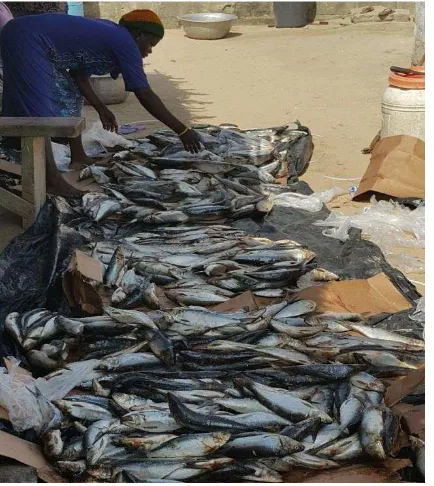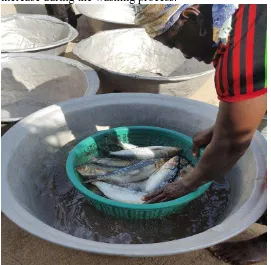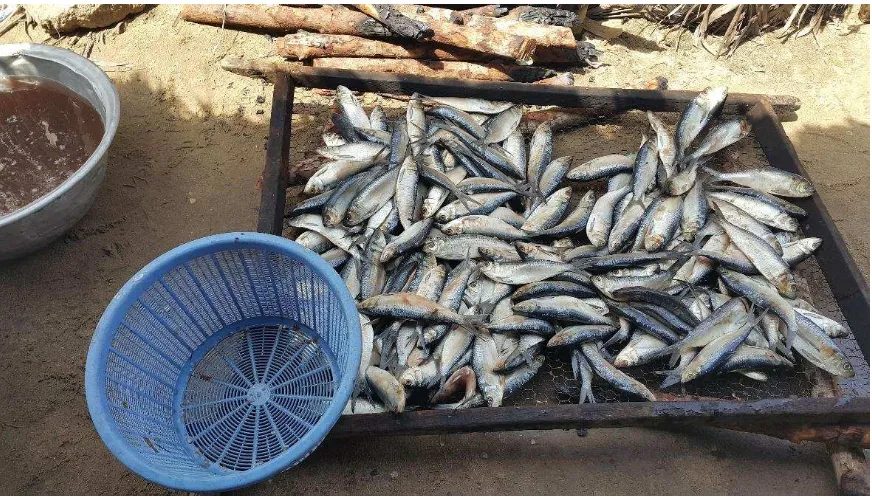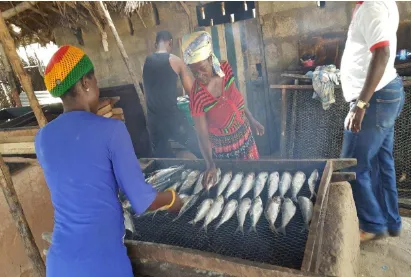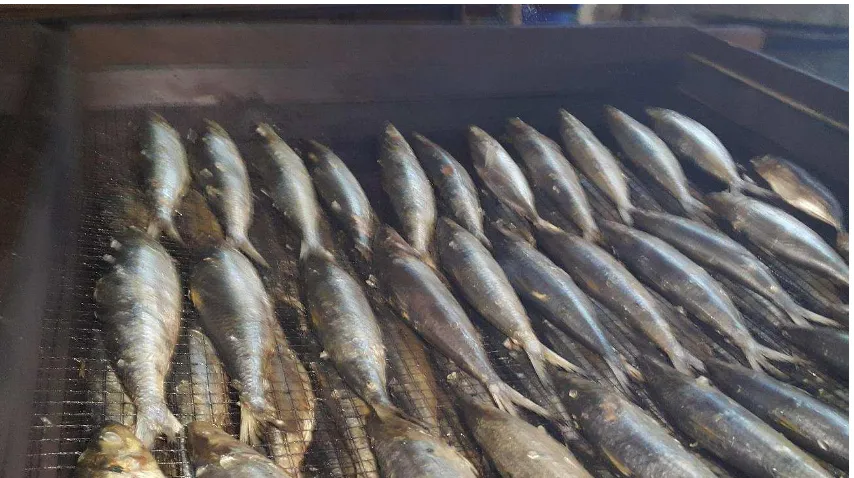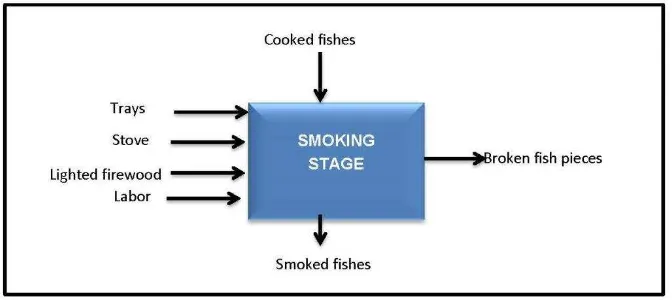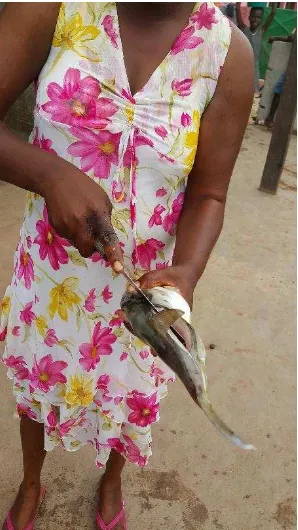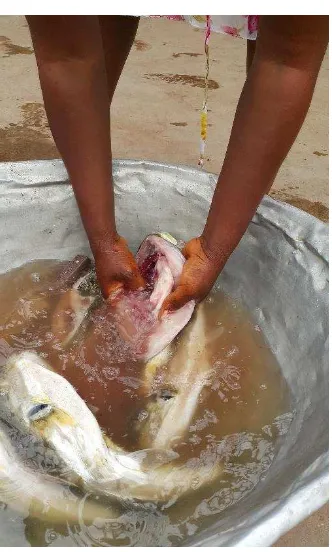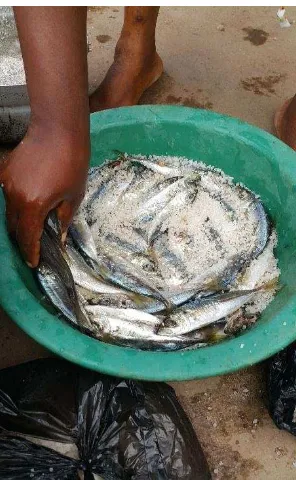SUSTAINABLE FISHERIES
MANAGEMENT PROJECT (SFMP)
Post-Harvest Process
Characterization Studies and Needs
Assessment Report on Fish
Smoking and Salting of Fish
This publication is available electronically on the Coastal Resources Center’s website at
http://www.crc.uri.edu/projects_page/ghanasfmp/
For more information on the Ghana Sustainable Fisheries Management Project, contact: USAID/Ghana Sustainable Fisheries Management Project
Coastal Resources Center
Graduate School of Oceanography University of Rhode Island
220 South Ferry Rd.
Narragansett, RI 02882 USA
Tel: 401-874-6224 Fax: 401-874-6920 Email: [email protected]
Citation: Entee, S. (2015). Post-Harvest Process Characterization Studies and Needs Assessment Report on Fish Smoking and Salting of Fish. The USAID/Ghana Sustainable Fisheries Management Project (SFMP). Narragansett, RI: Coastal Resources Center, Graduate School of Oceanography, University of Rhode Island and SNV Netherlands Development Organization. GH2014_ACT006_SNV. 29 pp.
Authority/Disclaimer:
Prepared for USAID/Ghana under Cooperative Agreement (AID-641-A-15-00001) awarded on October 22, 2014 to the University of Rhode Island and entitled; the USAID/Ghana Sustainable Fisheries Management Project (SFMP).
Detailed Partner Contact Information:
USAID/Ghana Sustainable Fisheries Management Project (SFMP) 10 Obodai St., Mempeasem, East Legon, Accra, Ghana
Brian Crawford Chief of Party [email protected]
Najih Lazar Senior Fisheries Advisor [email protected]
Patricia Mensah Communications Officer [email protected]
Bakari Nyari Monitoring and Evaluation Specialist [email protected]
Don Robadue, Jr. Program Manager, CRC [email protected]
Justice Odoi USAID Administrative Officer Representative [email protected]
Kofi.Agbogah
For additional information on partner activities:
CRC/URI: http://www.crc.uri.edu
CEWEFIA: http://cewefia.weebly.com/
DAA: http://womenthrive.org/development-action-association-daa Daasgift:
https://www.facebook.com/pages/Daasgift-Quality-Foundation-FNGO/135372649846101 Friends of the Nation: http://www.fonghana.org Hen Mpoano: http://www.henmpoano.org
SNV: http://www.snvworld.org/en/countries/ghana SSG Advisors: http://ssg-advisors.com/
ACRONYMS
AOR Administrative Officer Representative
ASSESS Analytical Support Services and Evaluations for Sustainable Systems CEMAG Community Environmental Monitoring and Advocacy Group
CCLME Canary Current Large Marine Ecosystem CCM Centre for Coastal Management
CDCS Country Development Cooperation Strategy
CEWEFIA Central and Western Region Fishmongers Improvement Association COMFISH Collaborative Management for a Sustainable Fisheries Future CoP Chief of Party
CPUE Catch Per Unit Effort CR Central Region
CRC Coastal Resources Center at the Graduate School of Oceanography, University of Rhode Island
CRCC Central Regional Coordinating Council CSLP Coastal Sustainable Landscapes Project CSO Civil Society Organization
DA District Authorities
DAA Development Action Association DAASGIFT Daasgift Quality Foundation
DFAS Department of Fisheries and Aquatic Sciences DFID Department for International Development
DO Development Objective
EBM Ecosystem-Based Management EG Economic Growth
EMMP Environmental Mitigation and Monitoring Plan ERF Environmental Review Form
ETP Endangered, Threatened and Protected
FAO Food and Agricultural Organization of the United Nations FASDEP Food and Agriculture Sector Development Program FASDP Fisheries and Aquaculture Sector Development Program FC Fisheries Commission
FCWCGG Fisheries Committee for the West central Gulf of Guinea FEU Fisheries Enforcement Unit
FHI Family Health International FoN Friends of Nation
FtF Feed the Future HM Hen Mpoano
GCLME Guinea Current Large Marine Ecosystem GIFA Ghana Inshore Fishermen's Association GIS Geographic Information System
GIZ Gesellschaft für Internationale Zusammenarbeit GLM Generalized Linear Models
GNAFF Ghana National Association of Farmers and Fishermen GNCFC Ghana National Canoe Fishermen’s Council
GoG Government of Ghana GSA Ghana Standards Authority
ICM Integrated Coastal Management
ICT Information, Communication Technology IEE Initial Environmental Examination
IR Intermediate Results
IUCN International Union for Conservation of Nature IUU Illegal Unreported Unregulated
JICA Japan International Cooperation Agency LEAP Livelihood Enhancement Against Poverty LOE Level of Effort
LOGODEP Local Government Development Program LoP Life of Project
MCS Monitoring, Control and Surveillance
METASIP Medium Term Agricultural Investment Program
METSS Monitoring, Evaluation and Technical Support Services MFRD Marine Fisheries Research Division
MOFAD Ministry of Fisheries and Aquaculture Development MOU Memorandum of Understanding
MPA Marine Protected Area
MSME Micro Small and Medium Enterprises MSP Marine Spatial Planning
M&E Monitoring and Evaluation
NAFAG National Fisheries Association of Ghana NGO Non-Governmental Organization
NC National Committee
NRM Natural Resources Management
PMEP Performance Monitoring and Evaluation Plan PMP Performance Management Plan
PPP Public Private Partnerships RAVI Rights and Voices Initiative RCC Regional Coordinating Council RFA Request for Application
RPA Rapid Partnership Appraisal SAMP Special Area Management Plans
SFMP Sustainable Fisheries Management Program SMEs Small and Medium Enterprises
SNV Netherlands Development Organization SS Spatial Solutions
SSG SSG Advisors
STEP Sustainable, Transparent, Effective Partnerships STWG Scientific and Technical Working Group
UCAD University Cheikh Anta Diop UCC University of Cape Coast URI University of Rhode Island
USAID United States Agency for International Development USG United States Government
WA West Africa
WARFP West Africa Regional Fisheries Development Program WASH Water, Sanitation and Hygiene
TABLE OF CONTENTS
Acronyms ... iii
1. INTRODUCTION ... 1
1.1 Post-harvest processing of fish in Ghana ... 2
1.2 Scope of Study ... 2
2. FISH SMOKING PROCESS CHARACTERIZATION ... 2
2.1. Thawing step ... 2
2.2. Washing and Sorting ... 4
2.3. Draining of water from Fish ... 5
2.4 Loading and arranging fish on trays for the cooking stage of smoking fish ... 5
2.5 Cooking Time or Stage of Fish smoking Process ... 6
2.6 Smoking time or stage of Fish smoking Process... 8
2.6.1 Comments ... 9
2.7 Storage of smoked fish for onward marketing ... 10
3 POST-HARVEST PROCESSING –SALTING OF FISH ... 14
3.1 Salting (soft salted fish)... 14
3.1.1 Comments/observation ... 16
3.2 Salting (Dry salted fish) ... 17
3.2.1 Comments/ Observation ... 17
3.3 Drying... 19
4 NEEDS ASSESSMENT/CATEGORIZATION REPORT OF COMMUNITY LIVELIHOOD DEVELOPMENT VALUE CHAIN AND POST-HARVEST IMPROVEMENTS ... 20
4.1 Fish smoking ... 20
4.2 Fish Smoking Stoves ... 21
4.3 Salting of Fish ... 21
Figure 2 Washing and sorting stage ...4
Figure 3 Draining of water from fish ...5
Figure 4 Arranging Fish on to Trays...6
Figure 5 Cooking stage ...7
Figure 6 Smoking stage ...9
Figure 7 Cutting of fish ...13
Figure 8 Removal of content...14
Figure 9 Washing of fish...14
Figure 10 Spreading of salt at the bottom of bowel ...15
Figure 11 Arranging of fish layers on top of salt layer ...15
1.
INTRODUCTION
The problem in Ghana’s Marine fisheries sector is complex, tragic, and too - common, severely over exploited fisheries put at risk tens of thousands of metric tons of local food fish supply and threaten the livelihoods of people and many more fisheries resource dependent households. The USAID-SFMP project intends to contribute to the reduction of post-harvest losses.
Under the USAID-SFMP project, a Post-Harvest Fish Processing Scoping Study has been carried out. This study looked at possible post-harvest fish processing technologies through a literature survey, identified the post-harvest fish processing technologies used in Ghana and identified the most important technologies. The study found that 95% of the fish processed in Ghana is smoked. The distant second most important technology is salting, which takes only 3% of the total fish processed in Ghana. The rest (drying and frying) are even less important. Based on the Post-Harvest Fish Processing Scoping Study, process characterization studies were conducted to study in detail the post-harvest fish processing technologies of fish smoking and fish salting. The findings are documented in this report.
SNV Netherlands Development Organisation undertook this research in Ada, Otuam, Elmina, Shama and Ankobra in Greater Accra, Central and Western regions of Ghana. This was to help us identify and understand the processing steps and challenges amongst others involved in the post-harvest technologies practised within the fishing communities. The study revealed that there were variations in technology (equipment) applied to the post-harvest processing of fish, which had varied effects on the processed fish products. It was noticed that in general there were no standard post-harvest processing protocols in the application of post-harvest technologies. The study revealed that healthy and sanitary conditions which is a prerequisite for preservation and uncompromised shelf life was very poor and needs to be addressed as matter of urgency.
It was also observed that the primarily application of preservation techniques in order to retain the quality and increase shelf life was rather played down for economic gains, which eventually affects quality, shelf life and the safety of consumers.
The research was also in partial fulfilment of the Sustainable Fisheries Management Project (SFMP) which seeks to rebuild fish stocks by ending overfishing of key stocks important to local food security through a multi-pronged approach.
The SFMP supports the Government of Ghana’s fisheries development policies and
objectives and squarely aims to assist the country to end overfishing and rebuild targeted fish stocks as a central goal. Adoption of sustainable fishing practices and reduced exploitation to end overfishing is the only way Ghana can maintain the sustainability of its marine fisheries in order to increase its local marine food fish supply and brings greater profitability to the fishery, with the potential to benefit millions of people indirectly.
Characterization of fish smoking, salting, process in general is to: 1. Help us identify the key steps in the various processes
3. Identify the very input i.e. materials, time, equipment etc. and outputs 4. Identify quantitative and qualitative indicators of the entire process
5. Enable us to make post assessment and review of procedures which lead to standardization, improvement of procedures and documentation.
6. Help us attain same results on repetition of the processing activity. 7. Know the Financial visibility of the entire processing
1.1 Post-harvest processing of fish in Ghana
In Ghana and for that amongst the six pilot areas, four main post harvest processing activities are carried out on fish. These are smoking, salting, drying and frying. The first three are mostly operated as commercialized business.
1.2 Scope of Study
The study was carried out in Ada, Otuam, Elmina, Shama and Ankobra in the Greater Accra, Central and Western Regions. The study covered the processing steps involved in each Post-harvest Process / methodology (Smoking and Salting) and equipment used in post-Post-harvest processing
2.
FISH SMOKING PROCESS CHARACTERIZATION
This study on fish smoking was carried out in all areas mentioned except Elmina. This was to help us find out whether there were variations in operating procedures; identify measurable indicators and equipment among processors and across locations.
Generally the processing steps were the same and cutting across all the locations with variations in the type of smoking equipment used. For instance the chorkor stoves were predominately used in the Central and Western regions; whiles some areas like Ada in the Greater Accra region had a number of Morrison fish smoking stoves (an improved version of chorkor) in use. This is because the area was a beneficiary of IFS project.
Places like Ankobra and Shama had benefited from a few improved stoves built by Kosmos, Tullow oil companies.
The following steps were identified: 1. Thawing (if fish is frozen) 2. Washing and Sorting
3. Draining of water from Fish
4. Loading and Arranging fish on trays 5. Cooking period
6. Smoking and drying period 7. Storage.
2.1. Thawing step
requires extra care to avoid breaking or tearing the fish apart. It was noticed that some do force thawing by using knife to separate the frozen fish from each other. Others soak the fish in water while some may also lift up the entire frozen pile up and slam it on the ground. But majority do not sprinkle water on the fish to thaw.
The force practices used in separating fish was noticed in some cases to have affected the quality of fish after thawing. Some fishes were broken and bruised; this leads to loss and quick deterioration after smoking and reduces market value. Forced thawing leads to destruction of the structural integrity of the fish.
Figure 1 Thawing Stage
Flow Chart
2.2. Washing and Sorting
These two activities were done simultaneously by the processors with sea water or water from a nearby water body. Sorting out was done to remove all fish broken or badly bruised that will give very low or no market value.
resistant microbes that are disease causing microbes. The microbial load on the fish could increase during the washing process.
Figure 2 Washing and sorting stage
Flow Chart
2.3. Draining of water from Fish
Figure 3 Draining of water from fish
Flow Chart
2.4 Loading and arranging fish on trays for the cooking stage of smoking fish
Figure 4 Arranging Fish on to Trays
Flow chart
2.5 Cooking Time or Stage of Fish smoking Process
Fish smoking in general involves two main stages. These are the cooking stage and the actual smoking stage. Fish smoking processors do smoke fish in two forms, either hard smoked or soft smoked fish.
The trays with the load of arranged fish are placed on the stoves. The trays are made to sit perfectly on each other to prevent heat escapes. Usually the numbers of trays used are eight (8). However, the number of trays can either be reduced or increased depending on the quantity of fish available for smoking.
process, there is intermittent checking by lifting the trays to check if the fishes are cooked. When fish in the lower trays are cooked, the trays are moved up and the top trays are brought to the lower levels. This is to prevent premature burning and to ensure that fishes are cooked evenly.
The cooking stage requires heat and not smoke, hence the stroking of firewood is done in such a way that firewood burns well to generate heat and not excessive smoke. The control of heat intensity is done by experience. The fuelwood is pushed further into the combustion chamber if the intensity of heat needs to be increased or vice-versa when the heat needs to be reduced.
In the of course cooking, the last top trays are partially covered in the case of the chorkor stove or completely uncovered. This is to allow moisture and volatile oils to escape. Some processors by experience do not push lighted firewood in the port area completely in the combustion area. This according to them prevents the dripping oil and water in the fish from falling directly into the fire. If this happens, the resultant effect is the generation of thick black smoke.
The texture and color of cooked fish at the end of the cooking stage usually looks as if the fish has been steamed. The fish looks drained of water and firm, with brownish leathery shinning skin color. The fish acquires quiet often patterns from the mesh of the trays.
The cooking times vary according to the types, sizes, quantity of fish and state of fuelwood (moisture content) and type of smoking stove being used.
Flow chart
2.6 Smoking time or stage of Fish smoking Process
This is the stage when aromatic flavors of smoke are impacted onto the fish whereas it is been dried gradually. The final outlook of fish smoked at this stage depends on the experience of the processor, type of stove, time of smoking and the type of fuelwood used. The FTT stoves and some other chorkor-like stoves have the smoking process done separately in different chambers. At this stage, the last tray is covered completely with the lid to ensure that the smoke stays in the tray sections to impact smoke and at the same time give the fish a dark color.
The smoking stage also requires that lower trays after some time when they are fully smoked are moved up and the top trays brought down. In some communities, the fish in the trays are turned around repeatedly during the process.
Figure 6 Smoking stage
Flow chart
2.6.1 Comments
Certain psychological behaviors were observed which cut across all processors in the locations visited. This was a shift from the traditional intention or idea of fish smoking. The primary intention is to extend shelf life over a period of time, at least a week or more. This usually implies that the smoking and drying time has to be extended. This culminates into more losses in weight, which does not attract high market premium for the fish hence fish processors only smoke to add color and aroma and play a balance to maintain weight in order to attract a high premium.
This is usually done amongst the big fishes e.g. Tunas and big Sardinellas. This phenomenon has led to fish processors churning out soft smoked fish products.
It was observed that some fish processors during the fish smoking stage burn wet weeds, fresh weed or sugar cane. This is to generate smoke and color to impart the smoked fish. It was reported by most processors that soft smoked fish does not last for long compared to the hard smoked fish. An enquiry for the reason from the processors was that it was because it was still soft after smoking especially Tunas, Salmons etc. however the actual reason is that the moisture contents for that matter the water activity (aw) is generally higher that the critical thresholds (0.99) which supports the growth of microbes. Hence, soft smoked fish can become a medium for the growth of microbe especially when consumed after 3 days. Unfortunately, many people eat soft smoked fish without necessary taking it through further process. There is the likelihood of ingesting active microbes when eaten. It would be very
2.7 Storage of smoked fish for onward marketing
After the smoking stage when the fish is well smoked, the remaining firewood is removed from the firepot area. Only the embers of the firewood are left in the combustion chamber to glow. The fishes in the trays are left to cool down completely to room temperature. This is to prevent moisture build up during storage. After cooling, the fishes are carefully arranged in cane baskets lined with paper from waste cement bags or old Newspaper prints. The entire basket is wrapped at the top with a net to secure the fish firmly in the baskets.
Flow chart
Table 1 Effects of the type of stoves used in smoking with regards to the following attributes in the table below
Sensory
Attribute Type of stoves used in Process Characterisation
CHORKOR COLOUR Brownish black Golden brown Brownish
Black brownish Light brown brownish
PARAMETRES CHORKOR
FISH TYPE Herrings Herrings Herrings Herrings Herrings Herrings Herrings
FISH STATUS Frozen Frozen Frozen Frozen Frozen Frozen Frozen
3 POST-HARVEST PROCESSING
–
SALTING OF FISH
Salting is one of the main post-harvest processing methods. This process involves the addition of salt (Sodium chloride) at a very high concentration to preserve the fish or prevent it from decaying. Salt compound serves as an inhibitory agent to microbes such as bacteria, fungi and other disease-causing agents that cannot survive in salt concentration environment or medium. This salting process as recorded during the process characterization is however distinct from fish fermentation, which involves microbial activity, that is allowed for some days before salt is added to halt or limit the microbial activity. In some cases, salt is not added at all but the fermented fish is dried.
The underlying principle of salting is osmosis. Salt creates osmotic pressure when added to fish by removing water molecules from the fish as well as microbes, which may be present. Two methods of salting are done in Elmina, and in Central and Western region. This results in either soft salted fish or dry salted fish.
In both cases, preliminary Preparations are done by washing and for the big fishes intestines and head; contents are removed and washed with sea-water.
3.1 Salting (soft salted fish)
Upon getting the fish, they are washed with sea water. Depending on the sizes of fish been salted, they are either opened up dorsally from the backside of the fish starting from the head straight down to the tail (anal fin) using a sharp knife.
Figure 8 Removal of content
Figure 9 Washing of fish
of the salt layer, this is done repeatedly till all the available fishes are arranged layer by layer alternatively with the salt layer.
Finally, salt is spread on top of the final layer of fish; cement paper is used to cover the entire last layer of salt. Heavy stones are placed on top of them, the stones are meant to put pressure on the layers of fish to press out water whiles salt applies osmotic pressure on the fish as well to extract water. By principle, these two activities are to reduce the water activity (Aw) to below 0.86, which prevents microbial growth.
Figure 10 Spreading of salt at the bottom of bowel
Figure 12 Cover with cement paper and placing stones on top
The covering or sealing of holding receptacle creates a hermetic seal, which cuts off oxygen from the entire system. This also initiates a minimal fermentation process, which lead to the development of aromatic flavor of salted soft fish. After 2days, the hermetic seal, which is the cement paper and stones, are removed. The fish is removed layer by layer and the remaining un-melted salt is brushed off the fish. This process is done until the bottom layer of fish is removed. What remains at the bottom is salty brown-reddish water and un-melted salt, this is washed away. The initial process of covering the bottom of the holding receptacle is done and fish arranged again. This is done layer by layer and interspersed with the salt layer. It is covered hermetically again with fresh cement paper and stone
During commercial production of soft salted fish, the fresh fish is first left for the initial putrefaction process to set in for about a day or two before filling into the holding receptacles layer by layer. Usually the remaining water and un-melted salt of the previous salting process is not emptied out. The next production is added, this poses a health risk.
3.1.1 Comments/observation
1. It was noticed that almost all the fish processors who produce salted soft fish use cement paper, which is highly unacceptable because of the obvious contamination, which could take place.
2. It was observed that the amount of salt used was done arbitrary without any background understanding measurement as to how much salt is needed to do the preservation.
3. It was noticed that the methods used in commercial production of soft salted fish were unhealthy and quiet unacceptable under food safety standards
Flow Chart-Salting (Small size fishes)
3.2 Salting (Dry salted fish)
3.2.1 Comments/ Observation
1. The use of sea-water is highly risky because it can increase microbial load on fish. 2. The use of bare hands during the salting process can harm processors over period of
time.
3. Although high platforms have been cemented by the processors themselves, the salted fish undergoing the drying process are exposed directly to houseflies which can contaminate the fish.
4. When the intensity of the sun is not high for the drying period of three days, the fish begins to go bad. A typical scenario arose when for 3days during the process characterization the sunshine intensity was low. This lead to the development of maggots in the fish.
5. What amount of salt is actually required for salting a particular amount of fish (must be determined for both soft and hard salting).
6. Determine at what level the salted fish is enough (reduced water activity for storage). 7. Develop handy tools, methods; techniques which will help processors know how well
PARA METERS MEASURED
HARD SALTING
SOFT SALTING
TYPE OF FISH AWUREE JAASE
STATE OF FISH FRESH FRESH
WEIGHT OF FRESH FISH (Kg) 3.2 3.2
WEIGHT OF SEA WATER (Kg) 7.2 7.5
WEIGHT OF DRESSED FISH(Kg) 3.0 2.9
DRESSING OF FISH (Time/mins) 20 20
WEIGHT OF FRESHLY SALTED FISH 3.8 4.4
WEIGHT OF SALT USED (Kg) 0.8 6.1
WEIGHT OF SALTED FISH FINAL PRODUCT(Kg)
3 9
PROCESSING TIM E (Mins) (3days) 5760( 4days)
COST OF FISH USED (GHc) 15.00 15.00
3.3 Drying
This post-harvest processing of fishes is quiet simple as compared to other processing activities like smoking and salting. Usually smaller fishes are processed by this method. The fish is washed clean with either sea water or any other clean water, they are then spread on a clean floor where it can receive direct sunlight and at one point in time; the fishes may be turned over with a long stick so that they may dry evenly.
4 NEEDS ASSESSMENT/CATEGORIZATION REPORT OF
COMMUNITY LIVELIHOOD DEVELOPMENT VALUE CHAIN AND
POST-HARVEST IMPROVEMENTS
The process characterisation and the energy audits studies conducted on the identified fish smoking stoves in the six communities in the Greater Accra, Central and Western regions. These two activities were also used as tools for assessing the needs of the two Post –harvest fish processing methods.
4.1 Fish smoking
It was evident throughout the studies undertaken in the six communities visited that, processors followed about 7 steps in processing frozen fish and about 6 steps if the fish is unfrozen. However there were practises at that fish thawing stage, Washing of fish, cooking and smoking stages of fish and storage of smoked fish, which per handling and hygiene standards were not being met as mentioned in the description of the process characterisation of fish.
There is the need to develop and adopt standard fish handling, hygiene and processing protocols for fish processing and to train fish processors and other stakeholders on these standard processing protocols through demonstrational workshops. Other training workshops such as Hazards Analysis Critical Control Point (HACCP) systems, Traceability and records keeping should be introduced to fish processors. Again grey areas of fish smoking processing procedures, .i.e. excessive used of smoke to impart colour to smoked fish which also leaves PAH deposited on smoked fish must be debated upon by stakeholders as to whether the practise must still be encouraged or stop (PAH known to cause cancer)
Microbial studies should also be conducted on smoked fish value chain (from the processors to the market sellers) to determine if there exist any correlation between microbial contamination of smoked fish and length of days it takes before consumption. It is also important to determine if there are still microbial contaminations immediately after smoking and if there exist, are they in save limits etc.
4.2 Fish Smoking Stoves
The Energy audits conducted by Institute of Industrial Research (IIR), on the performances and energy efficiencies of the Morrison and Chorkor, AWEP, another type of Chorkor at Otuam, KOSMOS Oven, Tullow Oven, KOSMOS Chorkor and FTT stove technologies, indicated that most of the stoves did not meet the EnDev requirements of 40% fuel or energy saving efficiency. Only the Morrison stove was better among the stoves, which was 36.7% more energy efficient when compared to the Chorkor-Ada. Again the Stove emissions were measured and analysed and revealed that all the stoves tested emitted high level of CO (Carbon Mono Oxides) and high levels of Particulate Matter.
PAH deposit. It also limits the marketing of smoked fish to only our local market, as smoked fish from Ghana does not meet international standard requirements of PAH levels.
The issues of standardization of stove dimensions need to be addresses through training of
stakeholder’s .i.e. artisans on the consistency of their stove construction dimensions of stoves.
4.3 Salting of Fish
It was observed that many salting activities were carried out on a large scale in Elmina and its surrounding villages with over 400 processors as an estimate. Salting in Elmina is done on Commercial scale and personal or home consumption. It was noticed that salted fish produced on commercial scale are done under conditions, which were at variance with basic hygienic practise. The use of spoiled fish for salting purposes was unacceptable. Environmental and Equipment sanitation was highly questionable. This calls for the need to develop standard salting and hygiene protocols tailor made for their niche of business. Training and demonstrational sections needs to be conducted for processors and other stakeholders. Local compliance teams needs to be setup to ensure that processors practise what they have been trained to do.
Microbial studies needs to be conducted on salted fish products along it value chain to ascertain if there are microbes present and to what extent or are they within safe limits. Further works needs to be done per what amounts of adequate salts levels is required to effective preserve fish as arbitrary amounts are applied by the salt processors.
5 RECOMMENDATIONS
• Develop PAH and CO profile study on all the identified stoves.
• Develop smoked fish production protocols and train partners on these protocols so that partners can also train fish smokers on the implementation of these protocols.
• Technology improvement should be done on the various identified stove to address CO and PAH issues.
• Research on microbiological profile on smoked fish.
• Develop handy tools, method; techniques which will help processors know how well fish is salted and dried for storage and onward marketing.
• Develop solutions for drying and housefly problems.
• Develop indicators to determine what amount of salt will be required for salting a particular amount of fish (for both soft and hard salting).
• Research on microbiological profile on salted fish.
• Develop salted fish production protocols and train partners on these protocols to also train processors on how to implement it
6 CONCLUSION
According to Antwi, 2006, various traditional methods are employed to preserve and process fish for consumption and storage. These include smoking, drying, salting, frying and fermenting and various combinations of these.
Lake Volta. Efforts are being made to improve the traditional methods of smoking, salting and drying.
However, with all these records, there has not been a clear literature for the step by step procedure to process fish in Ghana. This document has therefore spelt out clearly the step by step procedure on how to process fish through smoking and salting and its need assessment.
